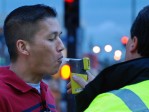DUI checkpoints. We’ve all been through at least one—the orange cones, the ominous “have your Driver’s License Ready” marquee, the spotlights. The first question you ask yourself might be: “have I been drinking tonight?” And that’s the kicker, that drinking and driving has become so prevalent in our community, on our roads, that we automatically associate DUI’s with driving under the influence of alcohol, when, surprise, non-alcoholic drugs, especially marijuana, have begun a steady trend of getting more and more drivers pulled over for impaired driving, and in worst cases, killed. But if researchers at Columbia University’s Mailman School of Public Health have proven anything with their recent study, it’s that non-alcoholic drugs such as marijuana may very well be upending alcohol’s death toll throne, and soon.
According to an article posted on Medical News Today:
“The prevalence of non-alcohol drugs detected in fatally injured drivers in the U.S. has been steadily rising and tripled from 1999 to 2010 for drivers who tested positive for marijuana — the most commonly detected non-alcohol drug—suggesting that drugged driving may be playing an increasing role in fatal motor vehicle crashes.”
The men and women at Colombia University started by examining crash data trends from 1999 to 2010, specifically the toxicology testing results on the drivers involved in fatal crashes. Out of 23,591 drivers killed within one hour of the crash, 39.7% were found to be under the influence of alcohol. This number, however, had stayed consistent over the course of the following decade. More disturbing is the fact that from ’99 to ’10, the rate at which drivers tested positive for drug impairment steadily rose from 16.6% to 28.3% (marijuana; 4.2% to 12.2%). All the results can be viewed online in The American Journal of Epidemiology.
According to Joanne Brady, a PhD candidate in epidemiology and the lead author of the study, there has been a marked increase from 2007 to 2013 in drivers testing positive for marijuana in roadside surveys, as well as an exponential increase in patients treated in healthcare settings.
On the flip side, it should be noted that the study’s results were restricted to the six states who regularly carried out toxicological testing onsite—California, Hawaii, Illinois, New Hampshire, Rhode Island, and West Virginia. Furthermore, like alcohol, the level of incapacitation on the driver can vary from person to person depending on the type of drug they may have abused, the dosage, and their physiological response to it. Lastly, it’s true that marijuana can stay in a person’s system for up to a week, and is not indicative of that person’s state of mind or body during the crash itself.
Regardless, the fact that so large an impact is noticeable on so small a scale gives cause to wonder as to what we might find if toxicological testing and checkpoints being rudimentary and implemented regularly in the other 44 states.








